

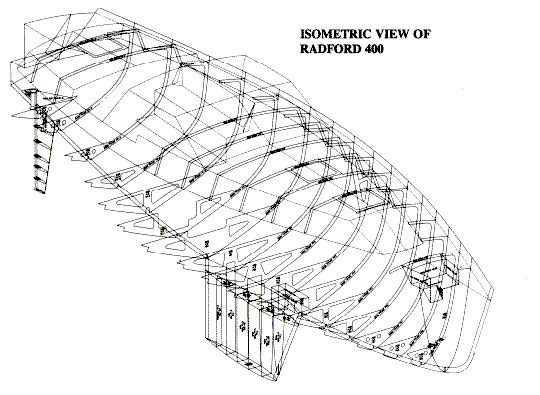
The aim of the R1000 Series steel kit yachts is to supply the owner and builder with an up-to-date design and construction method.
The primary requirement for an offshore cruising yacht is safety. This is inherent in the R1000 Series designs because they are designed for steel construction. For best safety the construction is not the only consideration. The sailing ability is also very important. The R1000 Series yachts are designed for excellent offshore sailing because they have the hull shape, waterline length, easy handling and good stability to make them very competent sailing yachts - not as fast as the " round the buoys" racing yachts listed in this site but at the top of their class for offshore cruising.
The hulls of the R1000 Series yachts have long waterlines and short overhangs, with the aim of reducing "unsupported" weight in the ends. On a yacht with short waterline and long overhangs this unsupported weight can induce pitching and be detrimental to the sailing ability of the yachts.
Another aspect of a long waterline (W.L.) relative to overall length is that the potential hull speed will be higher. Also, for a given displacement, the longer W.L. reduces the depth of the buttocks, reduces the wave "hollow" when underway and improves performance. A hull which has deeper buttocks and a short W.L. for the same displacement will be harder to handle once hull speed has been reached. A hull with a longer W.L. and flatter buttocks will have better directional stability.
The hull sections of the R1000 Series yachts have a pronounced vee which further contributes to the directional stability of the yachts. A hull with round section shapes and shorter W.L. doesn't have the same "built-in" directional stability as that of the R1000 Series yachts.
For a yacht designer it can be unsettling to know that most yachts are selected for their accommodation, often without sufficient regard to other important factors. In the case of the R1000 Series yachts it is comforting to know that the accommodation can be considered in the knowledge that the construction is sound and the performance accounted for.
For their length, this series of yachts has very good volume and carrying capacity, a major requirement in a cruising yacht. The accommodation drawings shown are an indication of what will easily fit in the different sized yachts. The accommodation is not structural so can be changed by the owner. The headroom in the main areas of the yacht is a minimum of 1.9m - 6'3". The yachts are designed so that most of the water tanks are below the cabin sole, leaving other areas of the boat for stowage.
This good accommodation volume is achieved without detracting from the appearance of the yacht. The freeboard is moderate to keep the centre of gravity of the yachts as low as possible. The house and cockpits are attractive and functional - to a shape dictated by the construction material. Weather protection is provided for the companionways with an overhanging hatch, and it is often feasible to have a cuddy cabin over the forward end of the cockpit for further weather protection, as illustrated on the centre cockpit R415.
Disregarding the requirements of accommodation, deck plan and sail plan, there are a number of basic requirements which must be taken into account when designing a cruising yacht. The three that most influence the final design are the construction material, carrying capacity for stores and equipment, and the amount of ballast.
As the steel construction weight is somewhat higher than other materials such as fibreglass or timber, the boats must be drawn with more displacement to adequately carry this weight and not detract from the carrying capacity of the yacht. As the R1000 Series yachts have been drawn to suit the American Bureau of Shipping Guide for Offshore Racing Yachts (A.B. S.), a little more allowance has been made for extra construction weight. There are lighter construction steel yachts around but they will have limitations placed on their usage as they are most unlikely to meet A.B.S. requirements and still float reasonably close to the waterline. Reductions in ballast may help the displacement figure but will detract from the sailing ability and safety of the yacht as will be discussed later.
Cruising people are attracted to steel construction because of its robust nature and safety. The R1000 Series steel yachts drawn to A.B.S. give a very strong construction for offshore sailing.
After closely studying the displacements of many different styles and lengths of cruising yachts the hull displacements for the R1000 Series were selected so that they could carry the stores and equipment that can reasonably be expected to be carried on a cruising yacht of a particular length. The hull shape also allows for a successful yacht over a wide range of displacements - whether the yachts are loaded or unloaded.
The sailing ability of a yacht depends on the upwind sail carrying capacity in moderate to fresh winds. This is determined by the amount of effective ballast and the location of the total centre of gravity of the yacht.
To get the most effective ballast it is necessary to use a keel with the highest density ballast and a minimum volume of keel. If lower density ballast is considered for a design, more ballast must be used to allow for the extra volume otherwise there is a loss in effective ballast. If a yacht doesn' t have sufficient stability and has to be reefed too early it may then not have enough sail area to drive it effectively to windward in fresh conditions. Satisfactory stability can be obtained by maintaining realistic rig and deck weights and a good ballast ratio.
Refer to the home page for a general stability discussion for offshore yachts and for the designs which have specific stability information included.
While the R1000 Series yachts meet the requirements to make them very good cruising yachts they go way beyond being just good, well detailed designs. The availability of the steel kits gives the owner the ability to complete the hull and deck with the minimum of problems in the least possible time. The following gives details on the kit development and assembly and the various options of length and layout.
While there is a certain simplicity to the kits in their final form it has taken a lot of design time and computer technology to achieve this result.
The hull shapes are 3D modelled on a hull surfacing program call Fast-yacht. The Fast-yacht package is used to create the lines and offsets, hydrostatics, keels, velocity prediction and rig engineering. The hull shape is transferred to another 3D CAD / CAM program called Caddsman (developed in Australia) where the deck, house, cockpit and transom are added to the model. Once the final decisions are made on the scantlings , i.e. frame spacing and sizes etc, the complete structure of the hull and deck is incorporated on the computer model. The individual components are then extracted from the model and components of like thickness are nested onto standard sized plates.
When the nestings are completed - to give the best utilisation of materials - an NC file is created to control the plasma cutter which produces the full size components. The components produced by the NC files are the equivalent of months of work if an individual was to loft, bend and cut one-off all the items required for the hull and deck. The accuracy of the computer modelling and cutting is also far superior to that normally achieved in one-off construction. The components cut for a round bilge design include hull frames, floors, keel floors, keel plating, keel base, ballast capping, stem & backbone, collision bulkhead, anchor locker, rudder & skeg plating and webs, mast step, engine beds, transom, boarding platform, deck & house plating - windows cut - deck & house beams, cockpit and companionway and hatch coamings.
The benefit of this work and development is greater accuracy, and reduced time in the construction of the hull and deck. Builders who use the kits readily acknowledge these benefits.

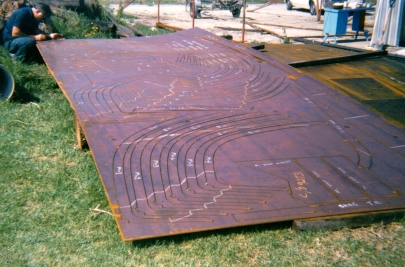
Photo shows plasma cut plate before removal of components ... |
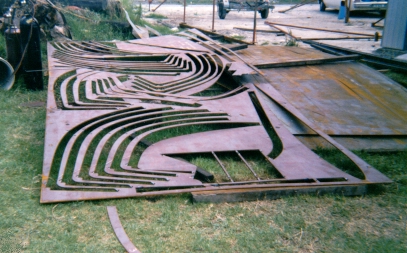
... and after removal of components. |
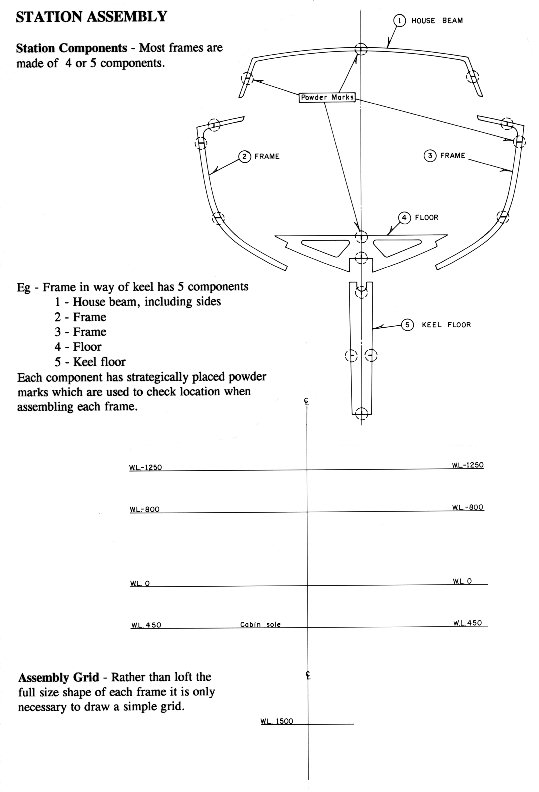 |
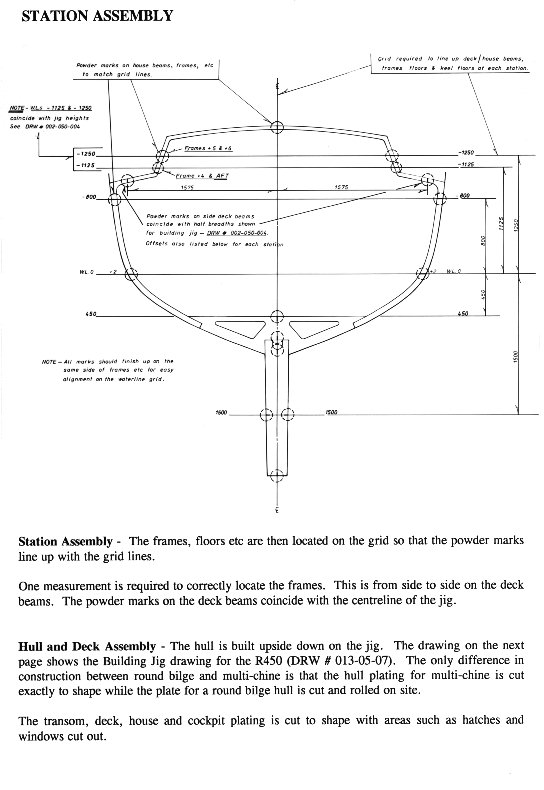 |
